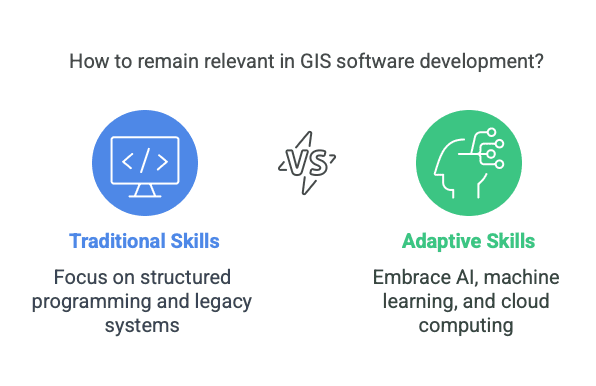Technology moves fast, and if you work in software development, you have to move with it. Samad’s story is a perfect example of what happens when you resist change—and how you can turn things around by adapting.
Getting Too Comfortable Can Be Risky
Samad was a C++ expert and a GIS software developer at SoftRekacipta Inc. He had spent years building robust spatial analysis tools, geospatial databases, and mapping applications. He was confident in his skills, believing that GIS development was all about structured programming, algorithms, and optimizing spatial queries. When AI in GIS started gaining attention, he dismissed it as just another trend.
But things changed. Companies started focusing more on AI-driven GIS solutions—automated feature extraction, predictive spatial modeling, and deep learning for remote sensing. New hires with Python, machine learning, and AI experience took on exciting projects. Samad, once at the top of his game, found himself maintaining legacy GIS systems while others worked on cutting-edge AI-powered geospatial applications. He wasn’t fired, but he wasn’t leading innovation anymore either.
GIS Software Development Is Evolving
Samad’s experience isn’t unique. GIS software development is shifting. AI, automation, and big data analytics are no longer optional—they’re becoming essential. Traditional GIS programming skills still matter, but companies now want developers who can integrate AI into geospatial applications.
This shift brings both challenges and opportunities:
- Job Security: GIS developers who don’t update their skills risk getting left behind.
- Learning New Tools: Understanding AI techniques like deep learning, geospatial data science, and cloud computing gives a major advantage.
- More Than Just Mapping: AI in GIS involves image classification, predictive spatial analytics, and intelligent decision-making—going beyond traditional geoprocessing.
How Samad Turned Things Around
Samad realized he had to change. Instead of resisting, he embraced the shift. He took online courses on AI for GIS, started learning Python and machine learning frameworks like TensorFlow and PyTorch, and even contributed to open-source geospatial AI projects. It wasn’t easy, but he knew staying relevant was more important than staying comfortable.
If you’re studying GIS software development, here’s what you can take from his story:
- Stay Curious: GIS technology never stops evolving. Keep learning.
- Don’t Ignore AI: Even if you don’t want to be an AI expert, understanding it will help you in your career.
- Think Beyond Maps: AI-driven GIS includes computer vision, data science, and predictive modeling—skills that will make you a better GIS developer.
- Be Flexible: The best GIS professionals adapt to new technologies and industry demands.
Will AI Take Over GIS Development?
AI is transforming GIS, but it won’t replace GIS developers. While AI can automate certain geospatial tasks, humans are still needed to design, interpret, and apply these solutions. The best move is to learn how AI works and use it as a tool, not see it as a threat.
Samad’s story isn’t about becoming obsolete—it’s about adapting and growing. The future of GIS software development belongs to those who are willing to evolve. If you want to succeed, start learning now and stay open to new opportunities!

